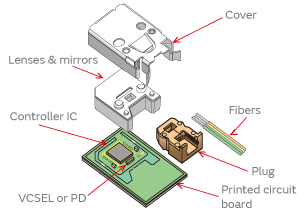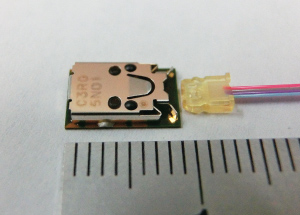A gradual shift toward cloud computing and widespread use of smartphones has driven a surge in Internet traffic, which has made fiber-optic communications a standard means even for the intra-traffic in the Internet data center. Murata's fiber optical transceivers for communication contribute toward high-speed high-throughput data traffic.
To cater to ever-increasing communication traffic and ever-demanding energy-saving policy in data centers, we must increase the capacity of fiber-optic communications. The data transmission capacity per unit active optical cable, or AOC, in the data centers which used to be 10 Gbps is now being increased to 40 Gbps. The evolution into the high-speed high-throughput data traffic has been in progress.
Murata has developed the MMC3 series as a fiber optical transceiver, or FOT, which was designed to be adapted for 40 Gbps and 56 Gbps QSFP+ AOC. The MMC3 series is equipped with unidirectional 14 Gbps/ch×4ch. The device size is 5.9×9.2×1.9 mm. This product is composed of a metal cover-shielded module component that houses an optical element (vertical cavity surface emitting laser, or VCSEL; or photodiode, or PD) , a controller IC, and optical path components (lenses and mirrors) mounted on the printed circuit board, and a plug with assembled glass fibers attached. The plug can be held by a latching tab on the metal cover after being inserted into the module. The transmitter circuit converts input electric signals to optical signals at the VCSEL for further transmission via the optical fibers. The receiver circuit converts optical signals received from the optical fibers to electric signals at the PD for output.
Characteristic of the module components is suitability for reflow soldering, with which common surface installation equipment can install them on the AOC circuit board. This will spare our clients complex manufacturing processes or high precision equipment, contributing toward a reduction in the manufacturing cost and an increase in the productivity of the AOC.

Internal structure of the FOT MMC3 series product

FOT MMC3 series

An example showing an FOT built in a QSFP+AOC component
Also currently under development for use in data centers is a unidirectional 25 Gbps/ch×4ch product with a further increased transmission capacity for 100 Gbps QSFP+AOC.
It is predicted that there will be an increasing demand for the AOC in the graphical data communications between factory automation equipment, computers, and displays, because of the high-speed high-throughput communication requirement and the transmission limit of metal cable, which the advancement of industry 4.0 and the launch of the 4K/8K broadcasting services will force us to face. For these purposes, we will provide the 2ch bi-directional products in addition to the 4ch unidirectional products.